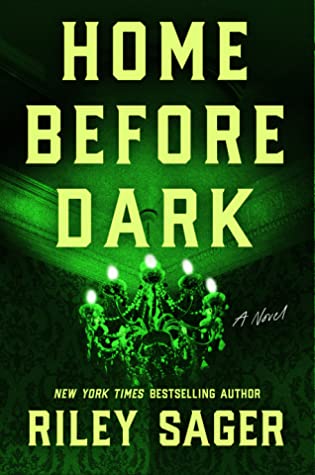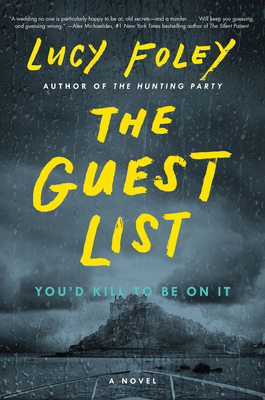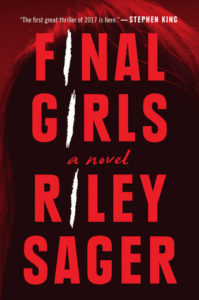
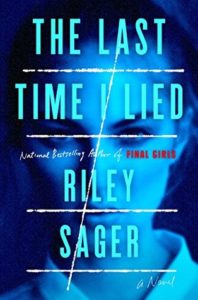

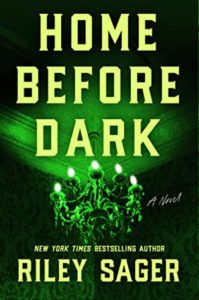
So, for some perverse reason, I ended up reading ALL of Riley Sager’s first four novels last September, after having read NO thrillers for decades. I didn’t intend to–my library hold of Home Before Dark, which I had planned to read in October (because spooky haunted house), came in early, I read it asap, and then I got the other books from my library as well. The funny thing is…I half-hated Home Before Dark? The buildup was fun, and the writing was great (insofar as I never noticed it–the mark, to me, of a solid thriller), but that fucking ending. So silly.
BUT, I liked the writing and the plot before the twists. SO I proceeded to binge the other three books in bursts over the next two weeks. It was like when I, a lactose-intolerant and IBS-suffering dumbass, periodically decide to get a milkshake or eat an entire bag of chips in one sitting…a bad idea, but it’s fun for awhile. Then it’s really REALLY not fun.
(For more not-fun times, check back next week for my thoughts on Survive the Night…)
After going full Tazmanian Devil on Sager’s books, I couldn’t fully differentiate between them, and, much like Taz, I had the overwhelming need to spit all my takes out at once. (Plus, this was LAST September, so my notes have been sitting in drafts for basically a year.) So, instead of writing up separate entries for all 4, I thought I’d do a roundup of my overall thoughts on Sager, his casual sexism, his really fucking wild racism-via-omission (like…there are NO featured POC in his novels, though it’s worse when the novels do mention other races…), and the way he fails to subvert that oh-so-fun thriller trope, murderers with mental illnesses.
These books were STILL fucking fun to read, most of the time, which probably reflects more on my dumb (white, cis, privileged) ass than anything else, but these were the whitest things I’d read in forever, until I read more thrillers. (Serves me right for reading a white dude pseudonymizing his way into a genre, I guess).
[One positive thing I WILL say, and I think it’s part of why I kept reading and had fun, is that these books–with the notable exception of Final Girls–do NOT use sexual assault as a plot point, a ‘growth’ experience for characters [shudder], or, for the most part, as a threat at all. Again, this does NOT apply to Sager’s first book, Final Girls, and I think if I’d started with that one I might not have continued.]
SPOILER TERRITORY-I SPOIL EVERYTHING
I read the novels from most-to-least recent, and I THOUGHT that was the order I most liked (or least-disliked) them in, notwithstanding how dumb I thought Home Before Dark got, until I got to the ending of Final Girls. That was one redemptive fucking ending, ideologically speaking. It gave me the opposite reaction as the endings of his other three novels. It also went a long way toward helping me understand how Sager blew the hell up, though I kinda think the whole “maybe the final girls are the REAL evil ones” twist he teased for at least 70% of the novel was the real MVP there. [Gag.]
But THE ENDING! I was prepped to write a whole section of my review castigating the copaganda in the novel, because the way main character Quincy and everyone else treated Jeff, her public defender boyfriend, was so pro-cop and pro-incarceration, I couldn’t stand it (though Jeff WAS a dick). BUT making loyal-cop Coop not only the killer BUT A SERIAL KILLER who’d killed ALL the other final girls…damn, Sager. That’s realism. [For what it’s worth, I don’t really think Sager intended an ACAB message, but here we are. I’ll take what I can get.] It also reversed the whole “mentally ill people are murderers” trope that the novel had been dancing around since the beginning. That was good, obviously, though the fact that Sager played it up for 90% of the novel means it’s what stuck in a lot of people’s minds, which…is just shitty.
Which brings me to one of my main beefs with Sager: what he highlights for the majority of the novels, and thus what gets embedded in people’s minds, is often exclusionary or bigoted. As previously mentioned, his novels star exclusively white people, and I’m hard-pressed to think of a POC character in even the smallest of supporting roles in ANY of these books. In Final Girls, the only non-white person I could spot was a nameless, faceless mugger whose “cocoa skin” at the back of their neck is one of their only identifying features (while our lovely protagonist is trying to beat him up). So, the one time non-white skin crops up, it’s in support of a gross, racist stereotype and on the body of a “bad guy” who’s being harmed by our white heroine. Fun times.
Final Girls also features a “joke” that the woods where the main massacre takes place are haunted by “Indian ghosts,” which becomes a tasteless, racist runner as the college kids taunt each other about it before they’re all summarily murdered. This is as close to Native rep as Sager’s ever gotten…[vomit. Also, for an excellent, Indigenous perspective on this bullshit, see Bear from Et Tu Brody’s excellent takedown from earlier this year]. In the year of our near-apocalypse 2017, that was just ridiculous. Maybe this is why I have low expectations for thrillers?
In murder-camp twist-fest The Last Time I Lied, again, it’s all white folks, and in that fun way where no one notices it’s only white folks, because it’s all white folks (sort-of the opposite of turtles all the way down). The ‘maybe he’s the murderer, maybe he’s just the pedo-adjacent love interest’ character, Theo, gets to claim the ultimate white privilege prize, though, as he’s at our murder-camp newly arrived from working with Doctors without Borders in “Africa,” and at the end he returns to that not-at-all-insultingly-nonspecific place. So I guess he’s just driving up and down an ENTIRE CONTINENT helping kids (he’s a lovely, lovely pediatrician, which isn’t at all terrifying given his aforementioned pedo-adjacent behavior at 19…shudder.)
In Sager’s worlds, white isn’t just the default…it’s the only option.
When it comes to gender, his shit’s more interesting, but still really problematic. Everyone’s cisgender and pretty much everyone’s straight, unsurprisingly, but much more surprisingly, he ONLY centers straight, cis white women…men play supporting roles. One of my friends, after hearing me describe the plot of a few of them, started calling them the “bitches be crazy” novels, and they certainly traffic in the casual misogyny and ableism that phrase invokes. Sometimes, Sager uses those stereotypes for awhile, only to upend them with one of his many (MANY) twists, but for the majority of the novel they’re usually being reinforced.
That’s not always the case, since the main antagonist in Lock Every Door is the dude that the reader (and the protagonist) thinks it is pretty early on, but I think that there, the twist is the proverbial ‘there is no real twist’ (except that the motive was organ harvesting instead of satanism …potato/potaahto). It also teaches what I think of as the Scream lesson (also known as the lesson of history and current reality), that if the white boy[s] seem suspicious, trust your gut. They did it.
[Random aside: for a real-world Lock Every Door situation, check out Samathan Hartsoe’s viral tiktok thread from this past March. Apartments are wild.]
Lock Every Door is very much about gaslighting, as is Home Before Dark, in a way (since the main character’s parents insist on their bogus ghost story to ‘protect’ her from the ‘truth’). However, the true ‘villain’ in Home Before Dark turns out to be a widow who accidentally murders one girl while stalking another and then tries to murder another decades later, but on purpose this time. If I’m recalling correctly, the widow became a widow because her depressive husband killed their daughter and himself in a murder/suicide in the house the main family moves into (hello again, wrongheaded mental illness stigma), so the widow becomes obsessed with watching the family’s little girl, Maggie, sleep. She accidentally killed the babysitter when she was discovered, but Maggie’s absolutely STAGGERINGLY silly parents think their 5 year old did it, so they hide the babysitter’s body in the ceiling, run out of the house, and pretend it was haunted by writing bestselling books about it (a la Amityville) FOR THE REST OF THEIR LIVES. It’s… choices were made. When Maggie returns to the house, the widow resumes watching her and decides to kill her for reasons. Women and their brains, who can even fathom…
(My absolute favorite part of all of this is the parents’ belief that EVEN IF little white Maggie had pushed her babysitter to her death, she’d be found culpable for murder and sent to prison. What a cartoonish idea. I feel like every other evil child horror story is predicated on the basic fact that this would NEVER happen, even when the evidence against sweet old Damien stacks up.)
As for The Last Time I Lied, that murder-camp fiasco, Theo–the former-pedo/doctor-without-borders–first gets teased as the possible fakeout killer, then it’s a working-class former counselor, followed by Theo’s brother, who tries to kill our heroine because she ruined his big bro’s life by accusing him of murdering her friends all those years ago. BUT, in a very-last-second twist, we learn that the TRUE cold-blooded murderer is actually one of those presumed-dead girls herself…sassy, sexy, sixteen-year-old wannabe-Pretty-Little-Liar Vivian. Who got away with it, disappeared into the ether, and re-emerged 15 years later rich, impeccable, remorseless, and ready to tell off the heroine at her weird art show. Turns out, Vivan had held a grudge against her other mean girl friends for her older sister’s death and lured them to their secret lake spot only to drown them, and then she transformed herself into the iconic rich-bitch she always wanted to be, but under a new identity. You know, in the normal way that sexy teen girls can bootstrap themselves from no money, no identity, and no family connections into immense fortune. Just like that.
And as I mentioned earlier, Final Girls plays with the idea that women are simply unhinged throughout, trying to make us think that Quincy might have murdered her friends, or at least aided in the murders, while also playing with the fact that Tina /Samantha isn’t who she says she is and was once institutionalized. Mess. And while that particular ableist shitshow gets reversed at the end, it’s not before Quincy, goaded by Tina, beats a random, defenseless addicted person into a COMA. And don’t get me started on how Quincy’s “anxiety” causes her blackout violent rages…WHAT?? But then It becomes another dangling plot thread, forgotten by the author perhaps but left to fester in the reader’s mind.
So I guess we’re left with a moral to these stories: Men might be murderers or they might not, but bitches REMAIN crazy.

